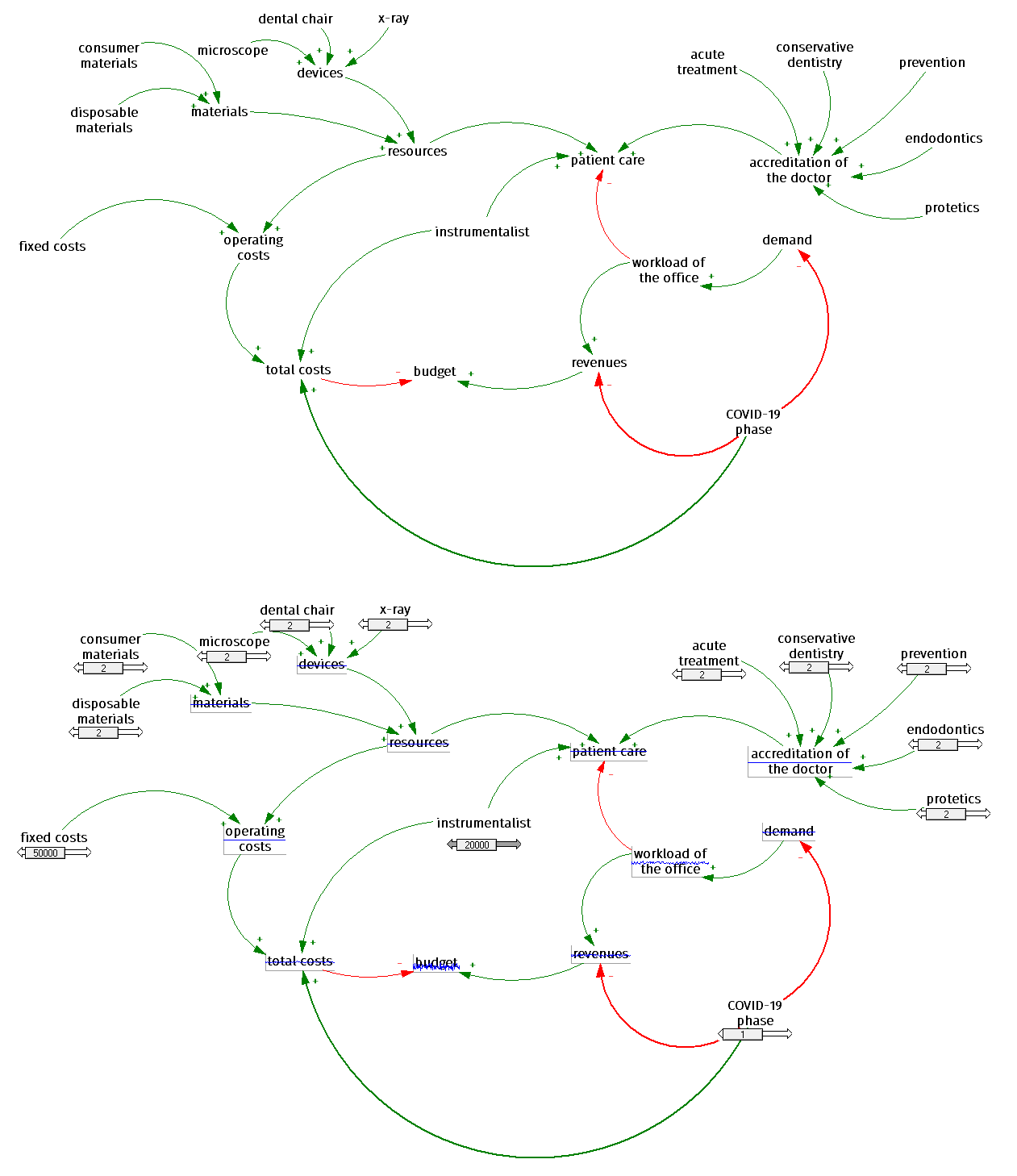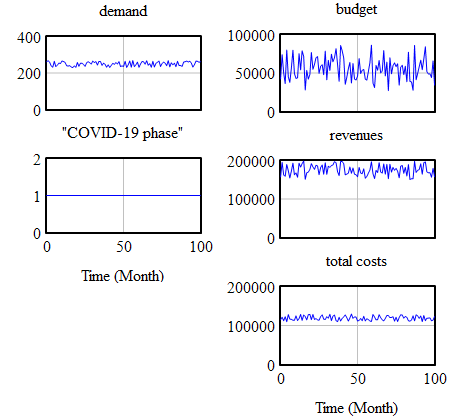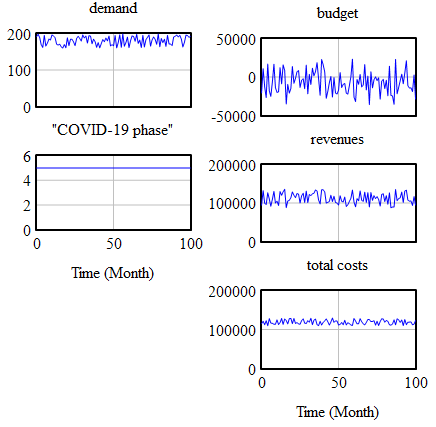Operation of private dental office
Introduction:
This page includes research report for the semester project and its requisities.
• Name of the simulation: Operation of private dental office
• Course: 4IT496 Simulace systémů v angličtině (ZS 2020/2021)
• Author: Bc. Alena Dufková
• Type: System dynamic
• Modeling tool: Vensim
Contents
Problem definition
The topic of the simulation was chosen with a view of understanding to the processes and connections in a dental office. The author already followed this theme in her bachelor thesis and is actively interested in becoming dental hygienist, if the main focus in informatics should not go well.
Simulated data and conditions are from a real private dental office situated in central Bohemia. The Simulation consists of the aspects influencing the company operations from within and from the outside. Nowadays even the COVID-19 is influencing the revenues and it impacts the common procedures at work. The goal is to help the specific dental office to see its progress and overall stats. They could see ¨some hidden opportunities that might be available once they get their hands on the simulation. Whatsmore the results should be appliable to any other average private dental office.
Method
When selecting the possible means to run the simulation, two options were considered. Using Simprocess or Vensim. Both programs can very practically capture the status and running of the company. They can also capture the needs of the company for its healthy life cycle. However, Vensim was eventually chosen, thanks to its more dynamic environment, taking into account the influence of COVID-19 on the operation of the company. These links would be far more difficult to capture with the unselected program.
Model
The most important thing is to know the environment and the people you work with. In this case of this work, it is a private dental office, in which there are exactly two employees, a dentist and an instrumentalist. To repeat the experiment with the best accuracy for your own case, it is necessary to have access to the information directly from employees of such an environment. This is a doctor's office located in a small town in Central Bohemian, where there is little to no competition. This applies to many dental offices in smaller cities, only the capital city of Prague has enough doctors to create a rivalry between companies, so we abstract from the variable aspect of "competitors." If one can redo this simulation, he or she must know how many devices there will be counted and what can their dentist perform and adjust this model to that. Logic behind is that if everything is working as it should, the performance is 100%.
General description of entities
The first and key aspect for the proper operation of the company is the accreditation of the doctor. This increases revenues the most. It is based on this attribute that it is necessary to know the staff of the surgery in order to record all the procedures that contribute to the well-being of patients.
Once there are introduced human units, I will mention other employees. In this particular case, it is precisely one instrumentalist who also contributes to patient care through her activities.
Another important equipment of the company is the resources to further increase the value. They are therefore materials and devices used to care for patients. Materials are usually of two types: consumer (fillings, rinsing water and others) and disposable (gloves, cups, cotton wool and others). They are usually very similar for all surgeries, due to the directives and regulations of the dental chamber and therefore they are not further broken down. The devices are more variable and each company may have different equipment, although some are certainly the same (for example, a dental chair) they are specifically listed.
All these facts contribute to patient care. The more valuable the patient care, the more rampant the interest in being treated in this surgery, and the higher the demand. The demand in this case are the orders of the patients. Unfortunately, this process is also influenced by COVID-19 today. Some procedures had to be completely canceled and many patients are even afraid to visit the surgery, even though they have been waiting for it for months.
Demand has a direct effect on the workload of the office. The busier it is, the more the surgery's revenues increases, whether from the pockets of patients or insurance companies. However, the capacity is of course limited and therefore, paradoxically, the potential patient care is reduced because no more patients can be recruited.
Of course, there are several types of costs present throughout the system. Operating costs are directly affected by fixed costs, which include, for example, rental or electricity costs, and resources that need to be financed. The total costs are thus enriched by operating costs and at the same time by the nurse's salaries. Budget is therefore mainly affected by total costs and revenues.
Furthermore, finally, COVID-19 was found guilty of further increasing total costs and reducing revenues. In connection with costs, these are mainly other materials that need to be procured regularly. In terms of income, these are lost profits for patients who were ordered but either did not come or could not be admitted to the building through directives (high fever and other symptoms).
All the numbers used in logical part were derived or simplified from the available informations in the dental office. They consist of minimums, maximums, percentages and averages.
Casual loop diagram
List of entities and logic
• accreditation of the doctor: summary of doctor's abilities (this case 100%); (IF THEN ELSE (acute treatment = 2, 20, 0) + IF THEN ELSE (conservative dentistry = 2, 20, 0) + IF THEN ELSE (endodontics = 2, 20, 0) + IF THEN ELSE (prevention = 2, 20, 0) + IF THEN ELSE (protetics = 2, 20, 0))
• budget: (revenues - total costs)
• demand: total demmand increased by patient care and daily average patients minus patients they've lost thanks to COVID-19 according to current phase; (RANDOM UNIFORM (280, 320, 0) - IF THEN ELSE ("COVID-19 phase" <= 1, 50, IF THEN ELSE ("COVID-19 phase" <= 2, 56, IF THEN ELSE ("COVID-19 phase" <= 3, 84, IF THEN ELSE ("COVID-19 phase" <= 4, 112, IF THEN ELSE ("COVID-19 phase" <= 5, 120, 0))))))
• devices: summary of available devices; (IF THEN ELSE (dental chair = 2, 33, 0) + IF THEN ELSE (microscope = 2, 33, 0) + IF THEN ELSE ("x-ray" = 2, 33, 0))
• instrumentalist: represents wage of the assistant; currently set on 20 000,- CZK
• materials: summary of available materials; (IF THEN ELSE (consumer materials = 2, 50, 0) + IF THEN ELSE (disposable materials = 2, 50, 0))
• operating costs: summary of fixed costs and costs given for taking care of the resources; (fixed costs+resources*200)
• patient care: there is atempt to state the dependence between workload and accreditations of the doctor and instrumentalist and also getting notice about resources, this variable mainly show the skill of the employees; (IF THEN ELSE (workload of the office >= (accreditation of the doctor - 90), -2, 1))+(IF THEN ELSE (instrumentalist/resources <= 50 :AND: accreditation of the doctor >= 80, 2, 1))
• resources: summary of available resources; (IF THEN ELSE (devices = 99, 50, 0) + IF THEN ELSE (materials = 100, 50, 0))
• revenues: workload multiplied by average profit per patient minus average lost profit of patients via COVID-19; (workload of the office *3.3* 750 - ((IF THEN ELSE ("COVID-19 phase" <= 1, 50, IF THEN ELSE ("COVID-19 phase" <= 2, 56, IF THEN ELSE ("COVID-19 phase" <= 3, 84, IF THEN ELSE ("COVID-19 phase" <= 4, 112, IF THEN ELSE ("COVID-19 phase" <= 5, 120, 0))))))*900))
• total costs: summary of costs average on month, used numbers were calculated based on daily costs due COVID-19 measures (disinfection, masks and others), first number given was too high because it was the maximum; (IF THEN ELSE ("COVID-19 phase" >= 1, RANDOM UNIFORM(20000, 40000 , 0 ), 0) + instrumentalist + operating costs)
• workload of the office: It gives the occupancy of the office in percentage. It is comparison between number of patients that the doctors can operate on on the maximum and demand; (IF THEN ELSE (demand >= 320, 100, RANDOM UNIFORM(79, 99 , 0 )))
List of variable entities and logic
• acute treatment: doctor's ability increases by 20%; value 1 means that the doctor is not accredited, value 2 means that the doctor is accredited
• conservative dentistry: doctor's ability increases by 20%; value 1 means that the doctor is not accredited, value 2 means that the doctor is accredited
• consumer materials: materials increases by 50% if available; value 1 means not available, value 2 means available
• COVID-19 phase: current COVID-19 phase diagnosed via "PES"; value 1 means phase 1, value 2 means phase 2, value 3 means phase 3, value 4 means phase 4, value 5 means phase 5; for random output there can be equation: (RANDOM UNIFORM(1, 5 , 0))
• dental chair: devices increases by 50% if available; value 1 means not available, value 2 means available
• disposable materials: materials increases by 50% if available; value 1 means not available, value 2 means available
• endodontics: doctor's ability increases by 20%; value 1 means that the doctor is not accredited, value 2 means that the doctor is accredited
• fixed costs: costs like rental costs increasing total costs; set to 50 000,- CZK as it is average fixed cost for this office
• microscope: devices increases by 50% if available; value 1 means not available, value 2 means available
• prevention: doctor's ability increases by 20%; value 1 means that the doctor is not accredited, value 2 means that the doctor is accredited
• protetics: doctor's ability increases by 20%; value 1 means that the doctor is not accredited, value 2 means that the doctor is accredited
• x-ray: devices increases by 50% if available; value 1 means not available, value 2 means available
Acquired charts via simulation
Results
The simulation proved the ideas from beginning. COVID-19 is indeed influencing the operation of the dental office. If the virus will spread more and more, the dental office needs to do some changes, because their profits might dangerously drop. They are two main ways they can go, to secure businnes continuity. To change something about the approach to the patients or something about total costs.
Due to the relatively linear increase in patient departure due to COVID-19 and its connection to phases, additional precautions are necessary to ensure that patients are not afraid to come. From the charts we can see that when the phase is in bigger number, people come less, as was expected. From the interviews, we discussed the topic of introducing COVID-19 tests directly in the workplace, the only problem is that such tests prepared on the spot do not have that high a percentage of success to be given so much confidence. However, patients may need to come because the teeth will need to be repaired sooner or later, so the line in the chart did not reach zero. However, in these times, only the ones who really must go to the dentist come. Therefore the revenues are still lower, because the more delicate procedures are not that demanded as before.
Furthermore, it is possible to increase the profit by expanding the dentist's knowledge, for example by attending school for acquiring the ability to perform serious periodontitis or surgery, but this option would require considerable investment and perhaps even interruption of the service. Or, in the more gloomy way, the salary of the instrumentalist might be reduced, as it is not at the minimum, author does not recommend that. From economics point of view, there might be a try to find more lucrative supplier of the appliances, but at what cost. In this area the quality is much more than the price.
Whatsmore, on the other hand, other variables are optimal and can be maintained.
Conclusion
In conclusion, the results were very pleasing, because they've met the expectations from the beginning. Model is functioning and can be easily modified on other similiar offices. The numbers within should not change that much, only when you want results for distinctly different office, or dentist approach (he or she might work without the insurance companies, therefore revenues are much higher, or they want to work less time the common average work hours).
Overall, the experience with the simulation was great and entertaining. Getting back with touch with friends from the dental field was refreshing, friendly and pleasant. Vensim is much complex program than i thought and should've put more time into constructing the model itself, the author spent too much time gathering evidence and then missplaced some relations in the handmade sketch.


